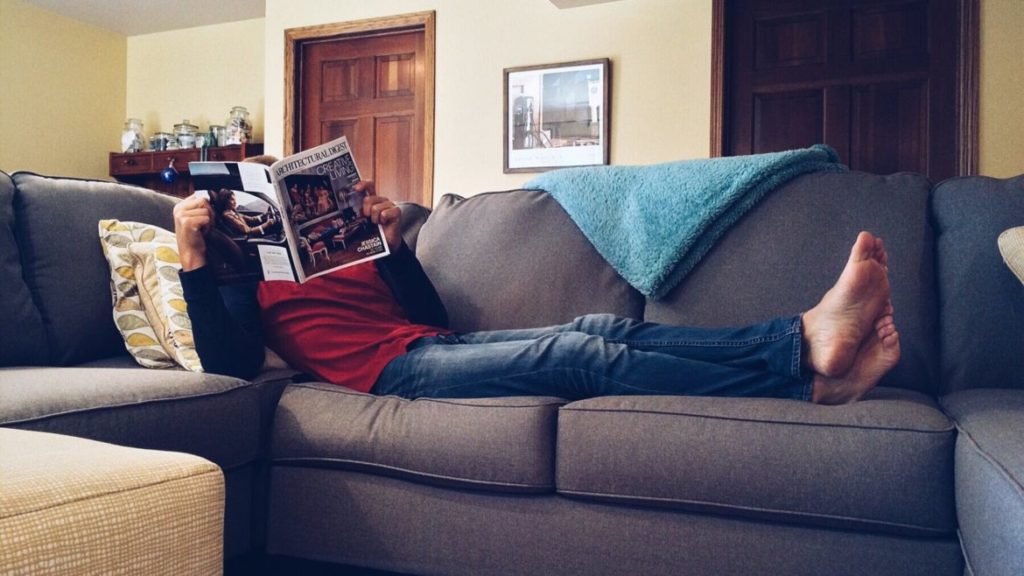It’s quite common to suffer from poor sleep or lack of sleep in general. However, solving this issue can be as simple as taking the time to relax before bed.
Aaron Rodgers said it best, sometimes you’ve just got to:
R-E-L-A-X
Relax!
We wanted to take a moment to share five easy relaxation techniques to help you get quality sleep without breaking the bank.
Here’s our list of 5 easy relaxation techniques:
Guided Visualization
To perform a guided visualization you need to lie in bed and tell your body to relax from head to toe.
“Forehead relax, eyes relax, cheeks relax,” and so forth suggests Joshua Jacobi, MD, from Pasadena, California. “Then, I picture lying on a beach. I bring in all the sensory awareness to the setting. So I feel the sand in my toes, the warmth of the sun, a cool breeze. I see the waves slowly coming in to the shore. I see palm trees waving in the wind. I hear the sound of the waves as they come in,” says Jacobi.
Try to picture this scene or something else that is relaxing for your individual taste.
Treat Your Anxiety
We talked a bit about your managing your anxiety in our 4 Steps To Getting Better Sleep blog post.
However, in order to relax you must truly treat your anxiety. You can do this by exercising, practicing yoga or visiting your doctor for the proper medication (if needed).
New Nostril Breathing
So, this might sound a bit weird at first, but alternate nostril breathing encourages deep relaxation by balancing the right and left sides of your brain while simultaneously calming your nervous system.
Here’s how to practice this method:
- Rest your right ring finger and thumb on either side of your nostrils, touching them lightly.
- Next you will take a big breath in and a big breath out, then close off the right nostril with your thumb and inhale through the left nostril for about four counts.
- At the end of that breath, close off the left nostril with your ring finger, hold and retain for a count of four and then release the right nostril and exhale for four.
It might take some practice to get used to, but you should feel free to repeat this for as many cycles until you’re relaxed and comfortable.
Count Backwards
Okay, so we’re sure you’ve heard of counting sheep to fall asleep, but have you ever tried counting backwards?
While lying in bed start counting backwards from 100. You must do it slowly, about once every second. Try to take your time when practicing this technique.
“The trick is this: If you get lost or forget what number you’re on, you need to start over again from 100. Every time you get lost, gently start over. Don’t allow yourself to become frustrated, just be gentle with yourself and start back over from 100,” says Phillip Mandel, a hypnotherapist in Beaverton, Oregon.
Why does this method work? Well, it’s both monotonous and sort of hypnotic.
“Note that it’s not hypnosis in the usual sense, such as ‘you are getting sleepy’. Rather, you’re just doing something monotonous with your mind that will have the effect of making you sleepy,” says Mandel.
Guided Imagery
Earlier, we talked about guided meditations, well now we’re talking about guided imagery!
What is guided imagery? “Guided imagery, a close cousin of meditation and hypnosis, can shift brain wave activity, and specific images can be learned that promote the brain’s movement toward deep, restful sleep,” says Leslie Davenport, a psychotherapist and author of “Healing and Transformation through Self-Guided Imagery.”
Here’s a visualization example for you:
Imagine a small ball of yarn. See this ball of yarn as holding the last bit of tension you may have. Find the tip of the yarn (the end piece) and just watch as the ball begins to roll slowly while it unwinds. As you see it unfurling and resting on the floor, you can see that it becomes longer and longer.
“Sense the decompressing. Feel the spaciousness around it now,” says Davenport. “As you watch the yarn, feel also the unwinding of any residual tension within you. Like tiny muscle fibers softening, watch as the ball continues to release from its very core, the soft yarn now stretched out, open, and completely at rest.”
—-
This list is not in any way a definitive list of relaxation techniques! There are a number of techniques you could try to really give you the ultimate relaxation feeling so you can reach a deep and quality sleep.
It’s up to you to figure out what works best for you individual body, and we cannot wait to see what techniques you choose to implement in your daily life.

